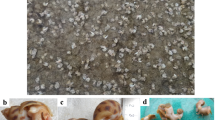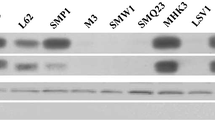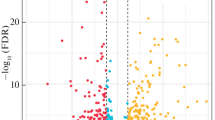Abstract
Vibrio anguillarum is part of the natural flora in the aquatic habitat, but under certain circumstances it can cause terminal hemorrhagic septicemia in marine fish due to the action of virulence-associated proteins. In our study, V. anguillarum MN and 3010 were identified as serotype O1 by AFLP analysis, and the virulence of V. anguillarum MN was shown 50-fold higher than that of the strain 3101 by LD50 tests with Japanese flounder Paralichthys olivaceus. Nine spots were noted as differentially expressed proteins by comparing the cellular and extracellular protein profiles of V. anguillarum MN and 3101. Mass spectrometry results showed OmpU and PrtV were highly expressed in the virulent strain MN but lowly expressed in the less virulent strain 3101. Expression level confirmed by semiquantitative RT-PCR showed that ompU and prtV were indeed highly expressed in the virulent strain MN. Together with similar amino acid sequences of both OmpU and PrtV in V. anguillarum MN and 3101, our study indicated that the expression level of OmpU and PrtV may be associated with the virulence of V. anguillarum.











Similar content being viewed by others
References
Actis LA, Fish W, Crosa JH, Kellerman K et al (1986) Characterization of anguibactin, a novel siderophore from Vibrio anguillarum 775 (pJM1). J Bacteriol 1671:57–65
Aeckersberg F, Lupp C, Feliciano B et al (2001) Vibrio fischeri outer membrane protein OmpU plays a role in normal symbiotic colonization. J Bacteriol 183:6590–6597
Austin B, Austin DA (1987) Bacterial fish pathogens: disease in farmed and wild fish. Ellis Horwood Ltd., Chichester
Berkelman T, Stenstedt T (1998) 2-D electrophoresis, using immobilized ph gradients: principles and methods. Amersham Pharmacia Manual, Piscataway
Chen Q, Crosa JH (1996) Antisense RNA, fur, iron and the regulation of iron transport genes in Vibrio anguillarum. J Biol Chem 271:18885–18891
Fan WH (2005) Identification of bacterial pathogens of cultured Turbot (Scophthalmus maximus) and primary study on the immunoprotection against the pathogens. China Ocean University, Qingdao
Ge L (2007) Development of membrane chip technology about identification and virulence genes detection of marine fish vibrios. China Ocean University, Qingdao
Hirono I, Masuda T, Aoki T (1996) Cloning and detection of the hemolysin gene of Vibrio anguillarum. Microb Pathog 21:173–182
Javier MZ, Mercedes A, Anicet RB et al (1996) Species-specific detection of Vibrio anguillarum in marine aquaculture environments by selective culture and DNA hybridization. Environ Microbiol 6:443–449
Lemos ML, Osorio CR (2007) Heme, an iron supply for vibrios pathogenic for fish. Biometals 20:615–626
Liu T, Belov ME, Jaitly N et al (2007) Accurate mass measurements in proteomics. Chem Rev 107:3621–3653
Manes NP, Estep RD, Mottaz HM et al (2008) Comparative proteomics of human monkeypox and vaccinia intracellular mature and extracellular enveloped virions. J Proteom Res 7:960–968
Mangan JA, Sole KM, Mitchison DA et al (1997) An effective method of RNA extraction from bacteria refractory to disruption, including mycobacteria. Nucleic Acids Res 25:675–676
Mikkelsen H, Lund V, Martinsen LC et al (2007) Variability among Vibrio anguillarum O2 isolates from Atlantic cod (Gadus morhua L.): characterisation and vaccination studies. Aquaculture 266:16–25
Milton DL, O’Toole R, Horstedt P et al (1996) Flagellin A is essential for the virulence of Vibrio anguillarum. J Bacteriol 178:1310–1319
Mo ZL, Guo DS, Mao YX et al (2010) Identification and characterization of the Vibrio anguillarum prtV gene encoding a new metalloprotease. Chin J Oceanol Limnol 28:55–61
Mouriño S, Osorio CR, Lemos ML (2004) Characterization of heme uptake cluster genes in the fish pathogen Vibrio anguillarum. J Bacteriol 186:59–67
Mouriño S, Osorio CR, Lemos ML et al (2006) Transcriptional organization and regulation of the Vibrio anguillarum heme uptake gene cluster. Gene 374:68–76
Pedersen K, Grisez L, Houdt R et al (1999) Extended serotyping scheme for Vibrio anguillarum with the definition and characterization of seven provisional O-serogroups. Curr Microbiol 38:183–189
Rodkhum C, Hirono I, Crosa JH et al (2005) Four novel hemolysin genes of Vibrio anguillarum and their virulence to rainbow trout. Microb Pathog 39:109–119
Salinas PC, Crosa JH (1995) Regulation of angR, a gene with regulatory and biosynthetic functions in the pJM1 plasmid-mediated iron uptake system of Vibrio anguillarum. Gene 160:17–23
Silva AJ, Pham K, Benitez JA (2003) Haemagglutinin/protease expression and mucin gel penetration in El Tor biotype Vibrio cholerae. Microbiology 149:1883–1891
Sorensen UB, Larsen JL (1985) Serotyping of Vibrio anguillarum. Appl Environ Microb 51:593–597
Sperandino V, Giron JA, Silveira WD et al (1995) The OmpU outer membrane protein, a potential adherence factor of Vibrio cholerae. Infect Immun 63:4433–4438
Stelzer S, Egan S, Larsen MR et al (2006) Unravelling the role of the ToxR-like transcriptional regulator WmpR in the marine antifouling bacterium Pseudoalteromonas tunicate. Microbiology 152:1385–1394
Stork M, Lorenzo DM, Welch TJ et al (2002) Plasmid-mediated iron uptake and virulence in Vibrio anguillarum. Plasmid 48:222–228
Tan YP, Lin Q, Wang XH et al (2002) Comparative proteomic analysis of extracellular proteins of Edwardsiella tarda. Infect Immun 70(11):6475–6480
Vaitkevicius K, Lindmark B, Ou GW et al (2006) A Vibrio cholerae protease needed for killing of Caenorhabditis elegans has a role in protection from natural predator grazing. PNAS 103:9280–9285
Vaitkevicius K, Rompikuntal PK, Lindmark B et al (2008) The metalloprotease PrtV from Vibrio cholerae. FEBS J 275:3167–3177
Wang SY, Lauritz J, Jass J et al (2003) Role for the major outer-membrane protein from Vibrio anguillarum in bile resistance and biofilm formation. Microbiology 149:1061–1071
Wilson K (1990) Preparation of genomic DNA from bacteria. In: Ausubel FM, Brent R, Kingston RE, Moore DD, Seidman JG, Smith JA, Struhl K (eds) Current protocols in molecular biology. Wiley, New York, p 2.4.1–2.4.2
Acknowledgments
This study was funded by the project under the Programme of Science and Technology Development of Shandong Province (Grant No. 2006GG2205005). The authors thank Dr. Kai-Ling Zhu in Qingdao University and Prof. Xuan-Xian Peng in Sun Yat-Sen University for their advice and comments in the writing and subscription of the manuscript.
Author information
Authors and Affiliations
Corresponding author
Rights and permissions
About this article
Cite this article
Zhao, P., Huang, J. & Wang, XH. Comparative Proteomics of two Vibrio anguillarum Serotype O1 Strains with Different Virulence Phenotypes. Curr Microbiol 65, 262–271 (2012). https://doi.org/10.1007/s00284-012-0156-x
Received:
Accepted:
Published:
Issue Date:
DOI: https://doi.org/10.1007/s00284-012-0156-x




